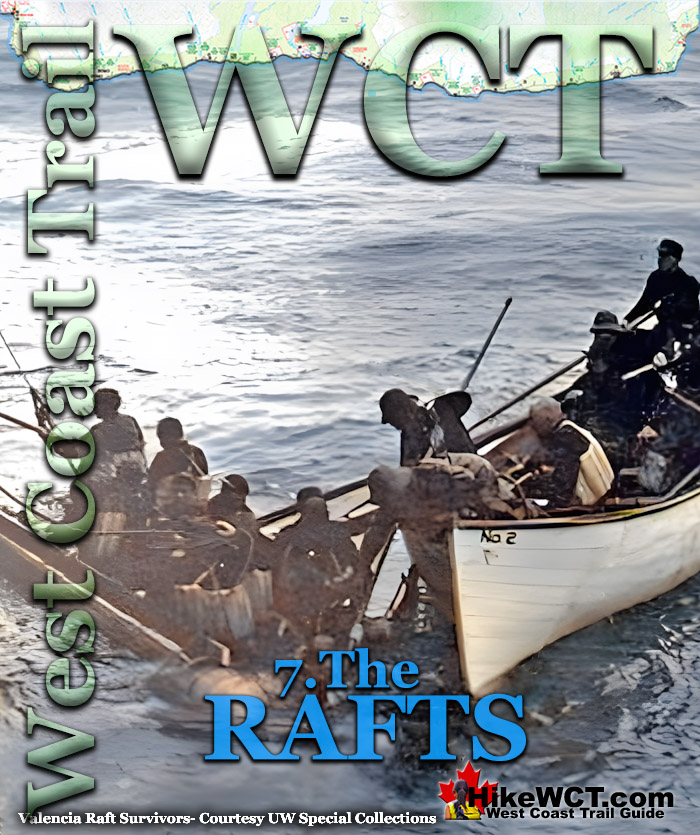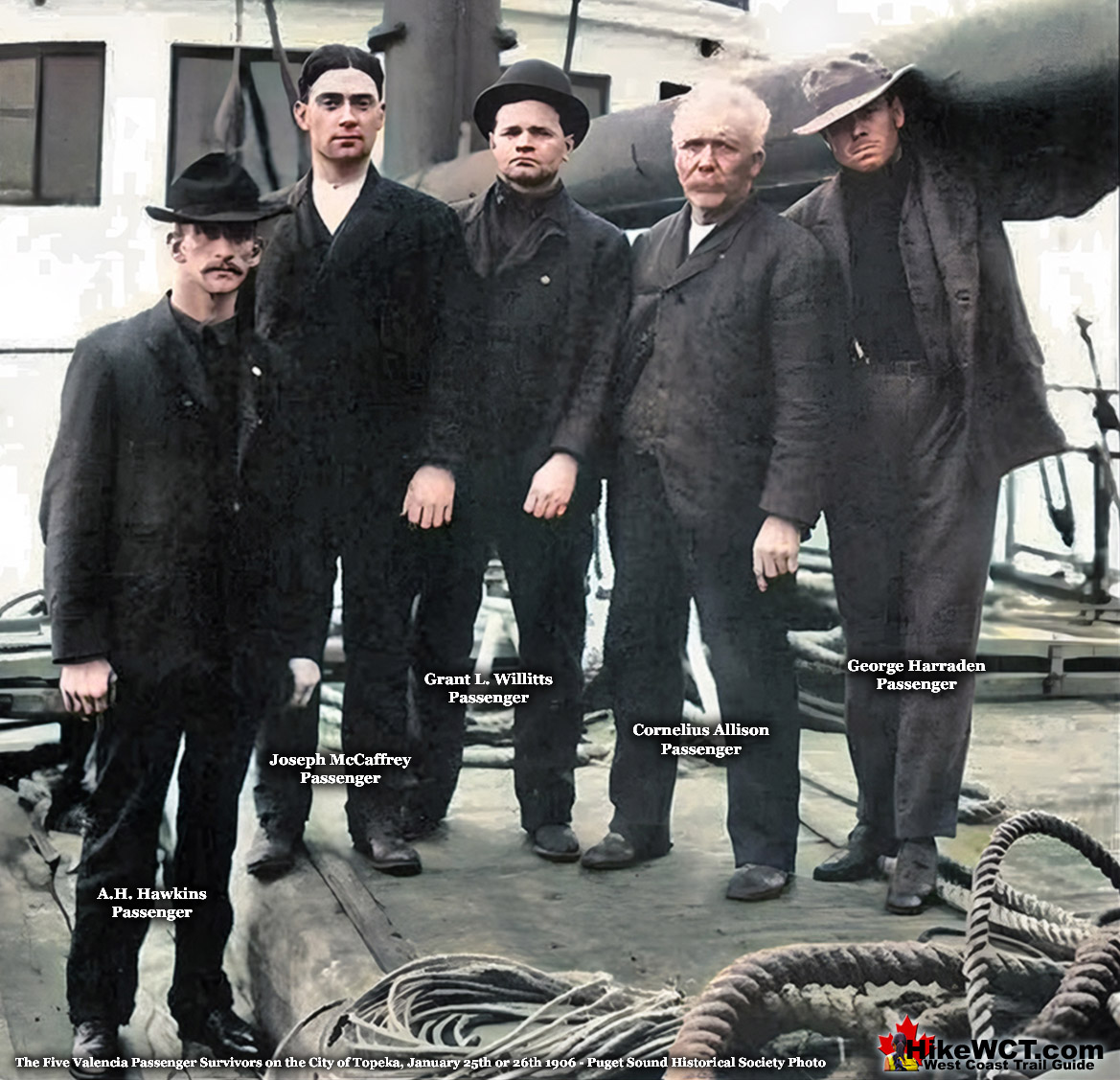![]() The Valencia wrecked just before midnight on Monday, January 22nd, 1906. Nearly 34 hours later, at 9am Wednesday morning the situation on the Valencia was horrific. Battered by waves, the ship was breaking apart and settling lower with every crashing wave that slammed into her. About 80 survivors remained clinging to the few upper parts of the ship still above water.
The Valencia wrecked just before midnight on Monday, January 22nd, 1906. Nearly 34 hours later, at 9am Wednesday morning the situation on the Valencia was horrific. Battered by waves, the ship was breaking apart and settling lower with every crashing wave that slammed into her. About 80 survivors remained clinging to the few upper parts of the ship still above water.
The Valencia Disaster
![]() 1. The Valencia
1. The Valencia ![]() 2. The Voyage
2. The Voyage ![]() 3. The Boats
3. The Boats ![]() 4. The McCarthy Boat
4. The McCarthy Boat ![]() 5. The Bunker Party
5. The Bunker Party ![]() 6. On the Valencia
6. On the Valencia ![]() 7. The Rafts
7. The Rafts ![]() 8. The Turret Raft
8. The Turret Raft ![]() 9. The Rescue Ships
9. The Rescue Ships ![]() 10. The Aftermath
10. The Aftermath ![]() 11. The Survivors
11. The Survivors ![]() 12. The Lost
12. The Lost
The West Coast Trail
![]() Prologue
Prologue ![]() 1: The West Coast Trail
1: The West Coast Trail ![]() 2: When to Hike & Fees
2: When to Hike & Fees ![]() 3: Trailheads
3: Trailheads ![]() 4: Getting There
4: Getting There ![]() 5: Considerations
5: Considerations ![]() 6: Campsites
6: Campsites ![]() 7: Shipwrecks
7: Shipwrecks ![]() 8: Routes
8: Routes ![]() 9: Sights & Highlights
9: Sights & Highlights
Rescue ships had appeared in the distance, however no attempt at rescue had been made. Thomas Carrick, first assistant engineer on the Valencia later recalled, “The first ship that hove in sight was the Queen. The weather was nice until that time, but the wind shifted and a choppy sea set in. The Queen stood off about a mile and a half. I saw two boats swinging from the davits as if they were in readiness to be lowered.” Sam Hancock, the chief cook on the Valencia remembered, “The Queen came within a reasonable distance and stopped. A short time after two other vessels came in sight. The Queen apparently spoke the vessels and a tug came towards us, but turned around immediately and went away. No boat was lowered by any of the vessels.” Joseph McCaffrey, a passenger would later testify in the Valencia inquiry, “When the steamers Queen, Salvor and Czar came in sight he thought that it would be a matter of only a short time before all were rescued. He thought the Czar might have come within 200 yards of the ship at the outside and drifted a raft down the vessel.” Knowing the ship could collapse under the waves at any moment, the crew decided to launch the last two life rafts and try to get to the rescue ships. The rafts were launched about twenty minutes apart and suffered very different fates. The first raft launched would become known as the Turret Raft and the second the Topeka Raft. The rafts are designed to float and remain stable, however those on board would be partly submerged and constantly soaked from waves crashing over the sides. The survivors on the Valencia were already freezing cold, hungry and thirsty and most refused to jump into the terrifying ocean below to get on the rafts.
Valencia's First Raft Departs Successfully
The first raft to be launched was not quite full, with just ten men on board. There were several reasons for this. First, it was doubtful the fragile and hard to maneuver rafts could survive in the churning ocean for long even if they could clear the breakers to get to the open ocean. Second, boarding the rafts was terrifyingly difficult. As the raft rose and fell in the enormous ocean swells it had to be kept a few metres from the Valencia to avoid it being smashed against the ship. To get on one of the rafts, you had to jump from the ship from a considerable height into the freezing ocean, avoid drowning or getting thrown against the ship, and swim your way to a raft. Yet another powerfully motivating reason was that many on the ship still hoped for outside rescue to come. With ships so close, how could it not?
Valencia's Two Life Rafts
Like most details of the Valencia disaster, you have to piece together many reports and details to paint an accurate picture. The carrying capacity of the rafts is one detail that is hard to figure out. Some reports say 18, others say 10. The Valencia Report simply states, "3 life rafts with a total carrying capacity of 44 persons". One of the rafts was lost the first night, so there seems to be no information about that one. Of the two rafts launched on January 24th, only the first, the Turret Raft was recovered. There are two very good photos of this raft in a warehouse days after being recovered. The Vancouver Maritime Museum captions it as the second raft, however the second raft was abandoned by the Topeka after they picked up the survivors and set off quickly in search of the first liferaft. The Valencia Report inspectors examined the first raft weeks later and managed to get 22 men on it, however, "it was obvious that 18 would crowd it seriously".
Turret Raft and Topeka Raft
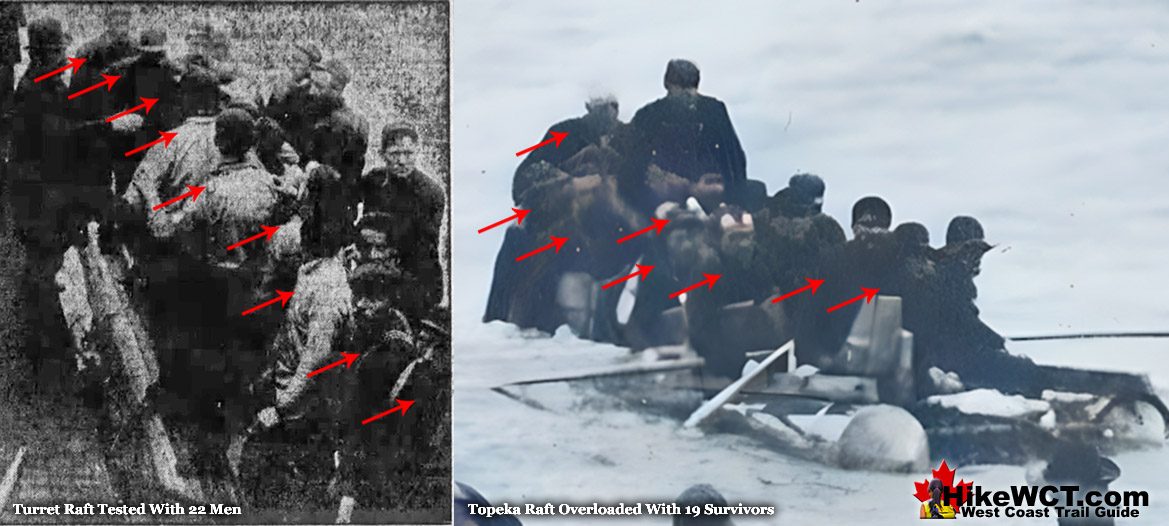
Comparing photos and descriptions it seems possible that the first raft bigger than the second. So, if the first raft could hold about 18, we can take a guess that the second raft was one designed for 12. Another clue is the mention from one of the raft survivors from the second raft that he understood the rafts were designed for up to 12, which makes sense when you see how overcrowded his raft appeared in all the pictures. If assume the Valencia Report was accurate in stating the total capacity of the three rafts was 44, and they tested the recovered raft and concluded it held a maximum of 18-22. From that we can make a guess that the second raft left behind by the Topeka was designed for 12 people and the third raft lost on the night of the wreck also held 12 people.
The Valencia Report inspectors incorrectly conclude that both rafts were identical and could carry 18 people each. They were not just different in capacity, but appear to be very different in design. T.H. Cann, Master of the City of Topeka testified that the raft he rescued (Topeka Raft) was "a metal raft, made by the Moran Bros... the thule raft is in Victoria".
Valencia's First Raft, the Turret Raft
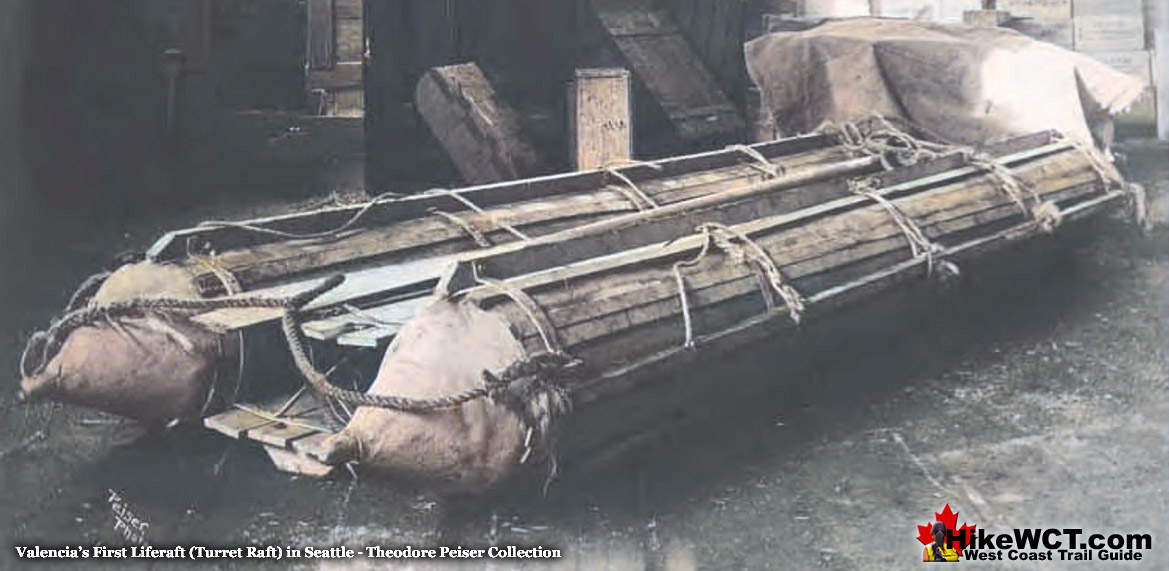
The rafts were not very buoyant and provided no protection from ocean waves as they sat so low in the water that the oars could not be used. The three oars on either side were designed to be fitted onto top of the long wooden boards that can be seen here on top of the pontoons. The survivors reported later that when they departed the Valencia the oars were mostly submerged and unusable. The oars had to be pulled out of the oarlocks and clumsily used as paddles.
Valencia's Second Life Raft
As the first raft departed, to ensure the ship in the distance, the Queen had spotted them, the captain fired the Lyle gun three times. Incredibly the clumsy, half submerged life raft broke over the breakers and out to sea with surprisingly little difficulty. The Valencia's second raft was now readied for departure with enthusiasm gained from the successful departure of the first raft. Six crewmen quickly jumped from the ship and scrambled on board the second raft to keep it a safe distance from the ship. On the Valencia several members of the crew tried to convince the women to board the raft, but they all refused. Thomas Carrick, first assistant engineer on the Valencia later recounted pleading with a young lady friend of his to go and finally convincing her, but upon reaching the rail and seeing the raft chaotically tossing in the violently crashing waves below, she went into hysterics and rushed away from him screaming.
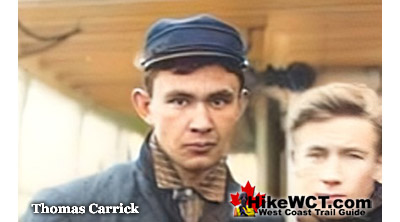 Valencia Engineer Carrick Jumps for the Second Raft
Valencia Engineer Carrick Jumps for the Second Raft
In an interview days later Carrick described the horrific scene on the Valencia before he jumped overboard to get on the raft, “The raft we left on was the last thing aboard the ship for anyone to get on. The Valencia was broken up and the two parts of her were ten to fifteen feet apart, the stern working toward the shore. The foremast was standing, but there was no one in the rigging. The only persons washed overboard that I saw were a woman and her child. The seas were very heavy and knocked us down unless we had something to hold to. There was only about fifteen feet of the hurricane deck left for us to stand on, and I should judge that there were fifty to seventy-five persons on this.”
Valencia Second Officer Peterson Barely Survives
The raft was then boarded by anyone brave enough to leap from the ship into the churning ocean and climb aboard. Peter Peterson, second officer on the Valencia described those moments well, “We had great difficulty in keeping the raft out of the whirlpool at the vessel’s side. The water was washing over the smokestack of the vessel, and at times the raft was tossed in the air. When the captain gave the word, I made a jump, and succeeded in grabbing a line to attach to the raft. I was already weak from hunger and exposure, and it was all that I could do to hold on. I finally succeeded in pulling myself aboard the raft.”
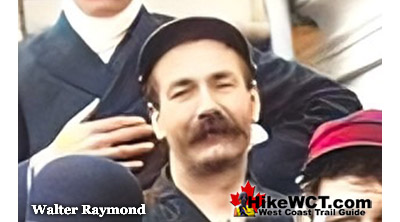 Valencia Messman Raymond Nearly Drowns
Valencia Messman Raymond Nearly Drowns
Walter Raymond, a messman on the Valencia remembered nearly drowning in his attempt. “I made a jump for the raft, and it seemed to me I would never again reach the top of the water. I had just sense enough left to not breathe and all the time my lungs kept paining until I thought they would break. Everything got black to me. This I know now, I was losing consciousness when, all of the sudden I popped up into the air, and, oh, what a relief it was. I someway did not seem to realize my position. When I did I looked for the raft and it was fully fifty feet from me. I gave up then for the first time since the Valencia struck. I was numb through and I never could have swum the distance. I was lifted by a gigantic wave and fiercely hurled through the air. I landed squarely on top of the boys on the raft and they grabbed me.”
Valencia's Second Raft Departs
Thomas Carrick, first assistant engineer recalled, “When we put off from the ship on the raft I called to my oilers in the rigging to come with us, but they refused. All the forward part of the vessel was under water at this time.” On the Valencia all the passengers crowded to the rail and wished them Godspeed and Thomas Carrick recalled the last words Captain Johnson said to him, “Goodbye Tom. For God’s sake try to save your passengers and crew.” The raft was packed with nineteen men and set off about twenty minutes after the first. n's Friend Disappears
One of the men on board the second raft, passenger Cornelius Allison recalled losing his friend probably when they hit the breakers. “I don’t know which was the worst experience – that on the ship or that on the raft. Both were terrible. One of the saddest things to me was the losing of my comrade Erickson. We had been together many years and both lived in St. Paul. Erickson and I were taking the trip up the coast on pleasure. We were both to go out on the raft and he was with me when I got on board. Where he went I do not know. After we got through the breakers I looked around and he was not with me.”
Conditions on the Crowded Second Raft
Carrick remembered the terrible conditions on the crowded raft, “We had a fearful struggle getting clear of the breakers. We were about 300 yards from shore. So many were on the raft that we all stood waist deep in the chilling water. The breakers roared and crashed over us. We worked our way seaward as the Queen came on. The oars had previously been lashed to the raft, but were useless under water. We cut them loose and two men were placed face to face, the oar placed between them, thus forming a human row-lock. These two men were braced by others pushing against their backs and sitting on their feet. I was on the stern of the over-freighted raft, attempting to steer. Buffeted and tossed about by the unrelenting sea, we continued toward the Queen. Hope was high, and everyone worked and shouted with might and main. The Queen rapidly drew away from us and finally disappeared from view. Most of the passengers were crushed with despair. Some of us did our best to keep up the spirits of the down hearted. Those not pulling an oar were becoming benumbed and chilled through with the intense cold and the washing of the sea.”
Cornelius Allison in an interview for the Victoria Daily Times recalled the desperate conditions. “It was terrible on the raft, the water was awfully cold. Our limbs became so benumbed that we could not even move them sufficiently to keep ourselves warm. I thought all would die of exposure. Huge seas came tumbling clean over, burying us beneath them until all suffered from swallowing water while trying to breathe."
Rescue Ships Disappear
On board one of the ships, the Salvor was a Daily Colonist reporter who witnessed the events from the perspective of the ships. In the January 28th edition of the paper he described how he was on the salvage steamer the Salvor, trailing behind the tugboat Czar and ahead of them and first ship to locate the Valencia was the Queen, a large ship, somewhat similar to the Valencia. The Queen spotted the Valencia at about 9:30am and stood by until the Czar and Salvor arrived. Captain Cousins saw survivors on the hurricane deck and in the rigging, but the Queen, a large 300-foot vessel with a 21-foot draft, was unable to approach closer than a mile. The ocean bottom was uncharted in this area and the sea was too rough. The Czar, a small ocean-going tug, made a run toward the wreck but started shipping water and withdrew.
On the Salvor the reporter wrote, “It was still raining hard and the shore was very indistinct, but it was not long before Capt. Ferris called out “There she is.” Many eager eyes were strained to catch a glimpse of her, but only at times was she to be seen, as the breakers were continually dashing entirely over her. A terrible sea was running and through the glasses the spray was seen to cover even the masts. The Queen stood out from the shore and the Salvor went in closer, while the Czar was still closer. From the Salvor all that was seen of the wreck was her two masts and her derrick.
After having stood in as close to the wreck as possible with regard to her own safety the Czar turned out and reported to both the Queen and Salvor that there were signals flying but whether any person was in the rigging it was impossible to say. The Czar made another trip to the Queen and back to the Salvor, and it was decided by those on the Salvor that it would be impossible to save anyone from the wreck from the water as to attempt to send in a boat would have undoubtedly resulted in the loss of a number of the rescuers. It was practically understood that the Queen would stand by the wreck and the Salvor and Czar would make for Bamfield Creek and send a party in over the trail.” It was reported later that the two ships departed at 10:15am, about the same time the Valencia's life rafts left the Valencia.
After the Salvor and the Czar departed the weather worsened and fog came in and the Queen could no longer see the Valencia. She was now two to three miles from the Valencia and had yet to launch any boats to go to the wreck. At around 11am the Queen departed, heading down the coast to Valencia. She passed another steamer, the City of Topeka also owned by the Pacific Steamship Company and company officials on board ordered the Queen to return to Victoria and back to work as a cruise ship. Frank Bunker, in an interview posted in the Victoria Daily Colonist on January 31st, 1906, learned of the conversation between the Topeka and the Queen. Captain Paterson of the Topeka asked the captain of the Queen if they had seen anything of the wreck. The Queen responded that she is in near shore, saw life aboard, people in the rigging and she is about three miles west of the big waterfall. Paterson then ordered the Queen to proceed to Victoria, and take up your passengers. The City of Topeka then cruised along the coast unable to find the Valencia.
Allison Remembers the Queen
Cornelius Allison, who lost his friend when the second raft departed, watched the Queen abandon them as they desperately struggled to paddle toward her. "The vessel which others aboard the wreck said was the Queen was standing about three-quarters of a mile off when the last raft left. Our object was to reach this ship, but before we had traversed a third of the way to where it was the vessel blew her whistle and steamed away. She made no effort at rescue, as far as I knew."
Agonizing Hours on the Raft
Carrick described the scene on the Valencia’s second raft after two agonizing hours, “Some of the men began blubbering and many were frothing at the mouth. It seemed that many were losing their minds." Valencia passenger Joseph McCaffrey recalled, "There were two or three men on the raft who kept up the spirit of their companions by cheering them on and holding out every hope of rescue within a short time." McCaffrey goes on to describe, as Carrick did, how the men were being driven insane by the conditions on the raft. Freezing cold, drenched in seawater and likely no hope of finding another ship. "If we had been an hour longer on that raft I believe every man would have gone insane." He could tell by the looks in the eyes of his companions that, "reason was departing. Just touch some of the men and they would growl like some trapped animal."
Finally a Ship is Sighted
Carrick remembered the moment the City of Topeka was sighted. "An incoherent shout from one of the passengers drew our attention and following his pointed finger we saw what afterwards proved to be the Topeka.” Freight clerk Frank Lehn recalled the excitement at that moment. “How we did work at the oars; every man strained at them for his life. The cold waves washing over us and the sleet beating on our heads was forgotten. Nearer and nearer we came to her and we shouted with all our strength, but as the wind was against us we could not make ourselves heard. The steamer was stopped and let drift with wind and current. Suddenly she started and turned out to sea. We almost gave up. If she had gone away, we would have died right there. But she came nearer us every moment. We had one of the men standing in the centre waving a boat hook with a shirt on it. At last their whistle blew as a token that they had seen us. How we shouted for joy. But by that time we could hardly move. The cold went through us and the rain seemed to pierce our very marrow. Finally, the steamer put out a boat, and when they at last made fast a rope and started to tow us to safety, I think I must have collapsed like everybody else on the raft.”
Valencia Second Life Raft January 24th, 1906

McCaffrey described the delirious exhaustion as they approached the Topeka. "When we sighted the boat putting away from the Topeka one fellow on the raft broke forth into a song. But the words died in his throat, his heart was too full. I don't know the words of that song he sang. I was too stupefied to remember." McCaffrey remembered pulling on the oars with, "a poor fellow whose strength was about exhausted. He would work like mad for a few moments and then his head would drop on his breast and his hands would relax their grasp. 'Keep on working,' I would urge. 'If you want to get out of this and reach the ship, pull, for God's sake, pull.' Then he would rise again to the task and in that manner we succeeded in reaching the boat crew from the Topeka."
Close to Death Before Rescue
Carrick also remembered how desperately close to death they were. “It seemed as though her arrival was a merciful messenger from God. In a few minutes she was alongside, but some of the men lay inert and powerless to grasp lines cast from the Topeka. Finally, all were hauled aboard and every attention was shown us by the rescue party. If the Topeka had not arrived when she did we would probably have been lost, all of us were rapidly succumbing to the intense cold.” The nineteen men picked up by the second raft, which became known as the Topeka Raft were: passenger Cornelius Allison, first assistant engineer Tom Carrick, fireman William Doherty, baker Charles Fluhme, passenger George Harraden, passenger A.H. Hawkins, waiter Charles Hoddinott, third cook John Johnson, coal passer W.D. Johnson, first assistant freight clerk Frank Lehn, passenger Joseph McCaffrey, waiter Patrick O’Brien, second officer Peter Peterson, fireman Paul Primer, messman Walter Raymond, quartermaster Martin Tarpey, waiter John Walsh, passenger Grant L. Willitts and fireman John Segalos. John Segalos is clearly visible in this picture taken from the City of Topeka the morning after he was rescued. After he was picked up off the raft he offered to help find the wreck of the Valencia. This picture was taken as he departed on January 25th, 1906. He is the man in the aft end of the boat, sitting sideways looking at the camera.
John Segalos, 25 January 1906
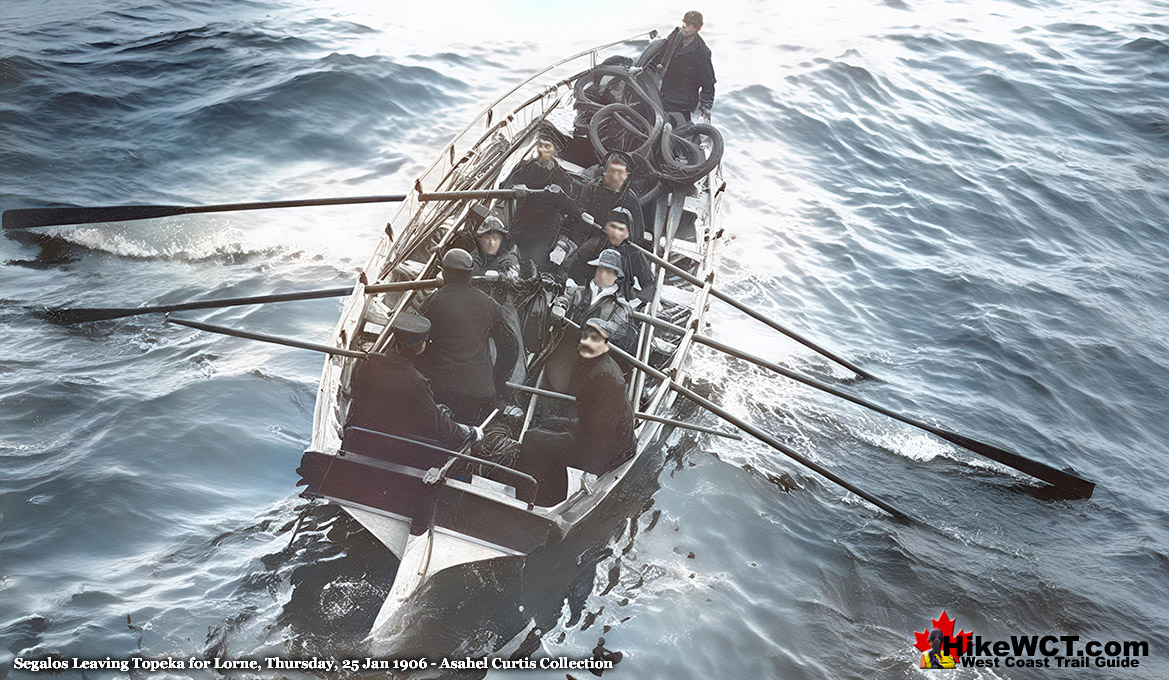
After their rescue, James Walsh, Walter Raymond and Patrick O’Brien were interviewed for the January 27th Daily Colonist and revealed their thoughts on boarding the raft. “In the first confusion more lives were lost than at any other single time. The waves washed everyone from the deck who failed to cling to something substantial. We went on the raft as a last hope and to our own surprise succeeded in reaching the ship.” Cornelius Allison was a first class passenger on the Valencia and one of the nineteen survivors picked up by the Topeka. In his sixties, he had been a sailor years ago and because he had some experience on ships he gave more forceful opinions than other passenger survivors. He testified during the Seattle investigation that, "the surf that finally battered the Valencia to pieces could not be called high." He criticized the rescue ships for not attempting any assistance. "The vessels at sea stood off and made no attempt to lower a boat... There might have been some excuse for the Queen's not coming in closer, but there was a tug lying alongside of her that did not come any closer than the large vessel. It all looked wrong to us." Asked about the weather when they were picked up by the Topeka, he replied, "It was a trifle foggy, but there was no wind blowing. The waves did not have combers on them. I do not see why a boat could not have been lowered." This amazing photo shows the men from the second raft being helped on board the City of Topeka. Cornelius Allison is the grey haired man sitting in the lifeboat wearing the life vest.
Valencia Survivors Boarding the Topeka
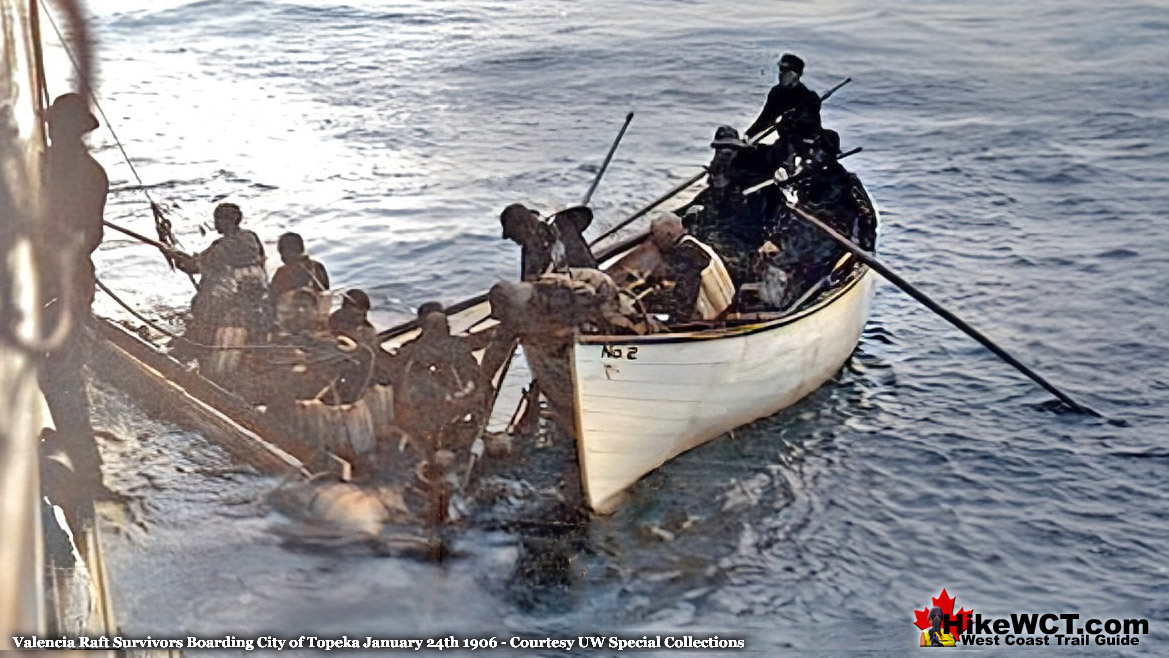
The Five Passenger Survivors After Rescue
This amazing photo was taken after the rescue of the Topeka Raft. These were the five Valencia passengers that were on the Topeka Raft. A.H. Hawkins, Joseph McCaffrey, Grant L. Willitts, Cornelius Allison and George Harraden.
Topeka Raft Survivors in Seattle
This photo of the Topeka Raft survivors appeared on the cover of the Seattle Star newspaper on January 26th, 1906. The survivors shown are, second officer Peter Peterson, passenger Grant L. Willitts, first assistant engineer Thomas Carrick, passenger George Harraden, passenger A.H. Hawkins and passenger Cornelius Allison. The photo was taken in Seattle shortly after arriving on the City of Topeka. The newspaper reported, "All were in an emaciated and tattered condition when reaching port. They had saved nothing but the clothes upon their backs, and this, with many of them, was reduced to rags. A few had a little money in their pockets; the majority little or nothing. In the hours aboard the stricken Valencia, when grim death lurked so near. It was not money or personal effects that the people thought of. It was life, so sweet and dear when it seemed so certain of being lost, and consequently these survivors came to the city broken in spirit and badly off for means of sustenance." The Pacific Coast company, the owners of the Valencia provided the men everything they desired and taken to clothing stores, restaurants and given rooms at the Rainier Grand. The men living in San Francisco were given tickets to get them back home. The Pacific Coast has, "opened its purse with an unstinted hand to overcome as far as possible the inconveniences thrust upon the survivors through the disaster."
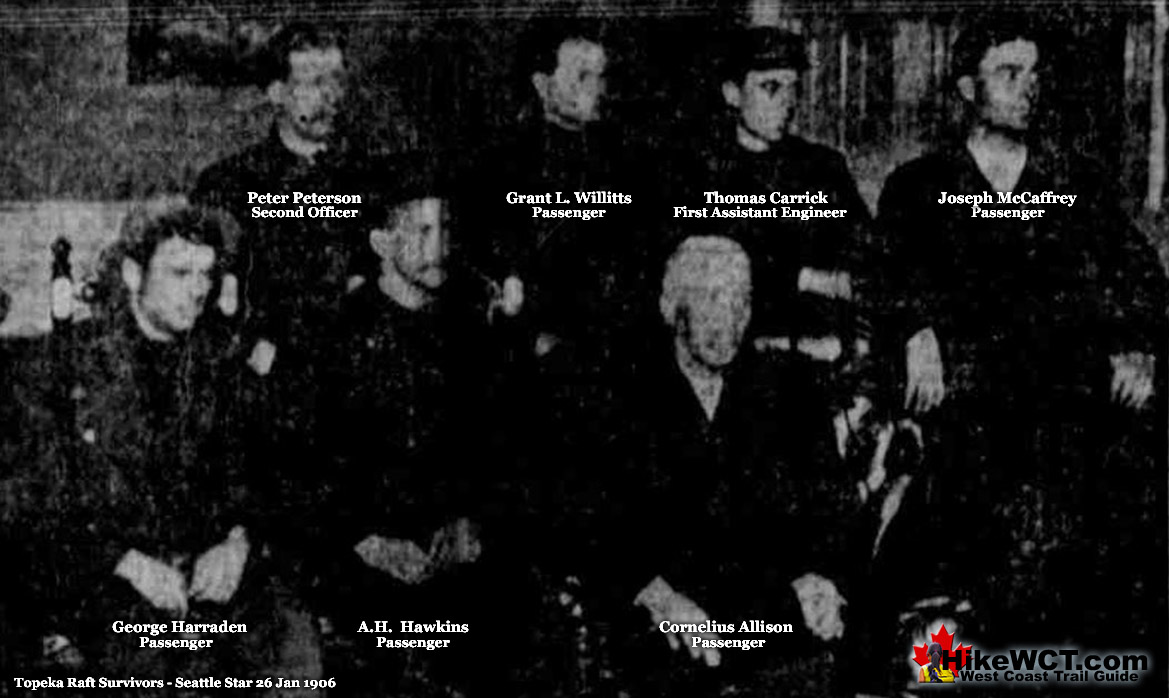
Some of Valencia's Crew on the Topeka
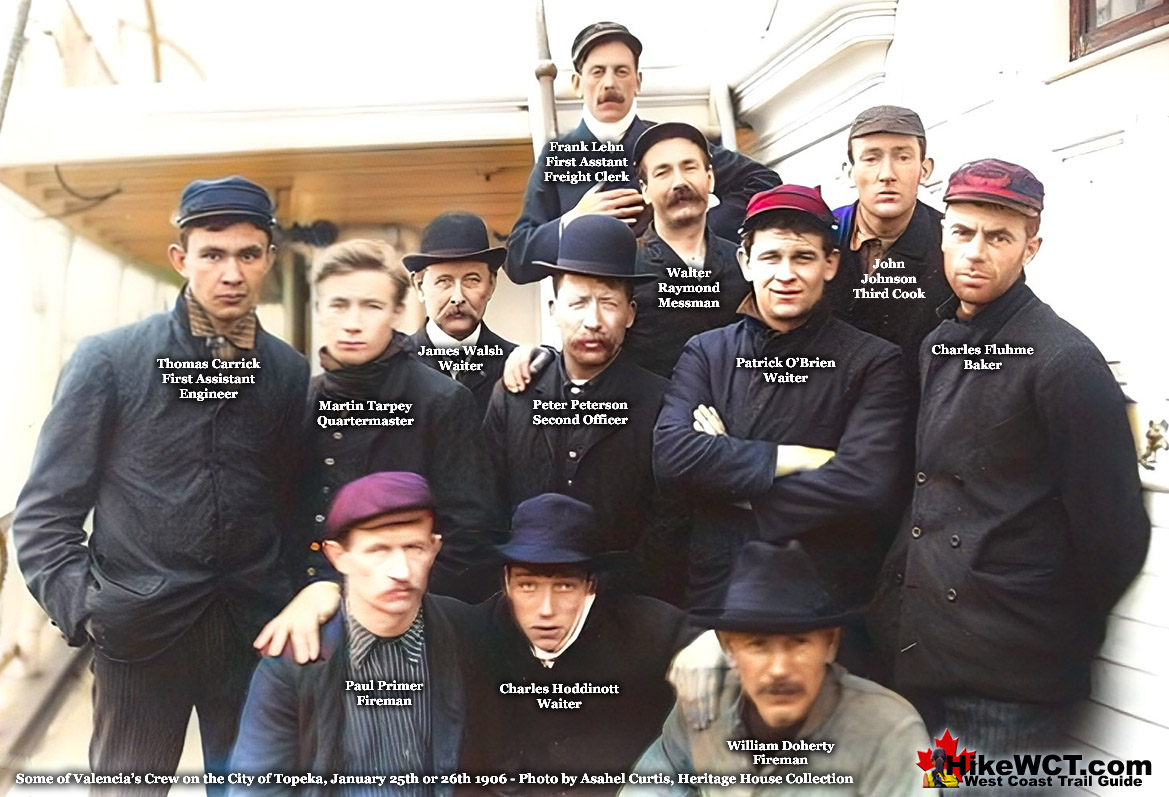
Best West Coast Trail Sights & Highlights
The Valencia Disaster

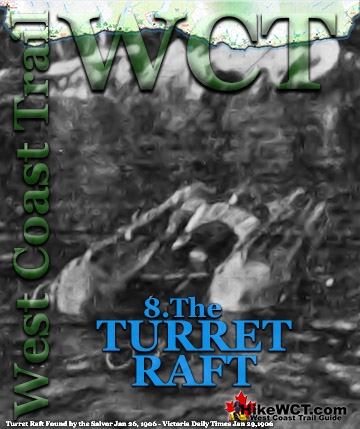

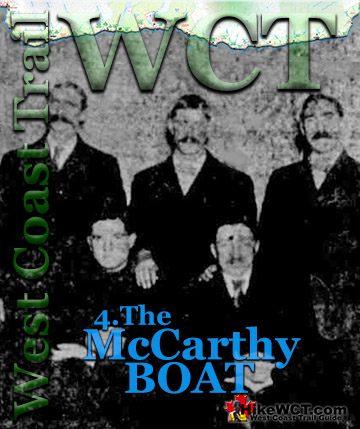
West Coast Trail A to Z


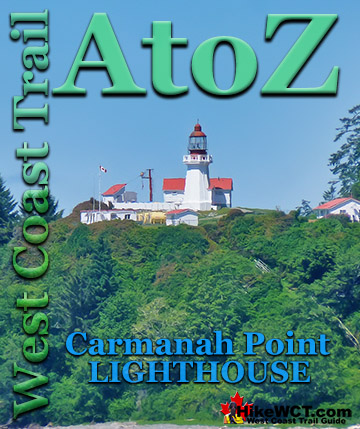
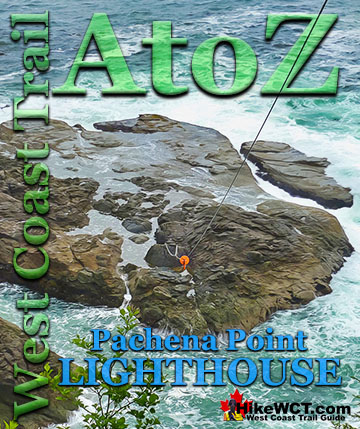
The West Coast Trail by Day
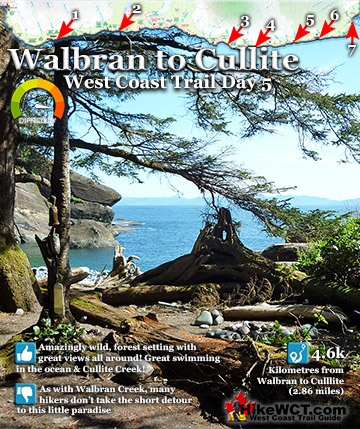
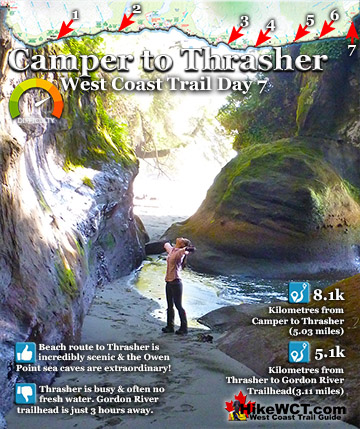
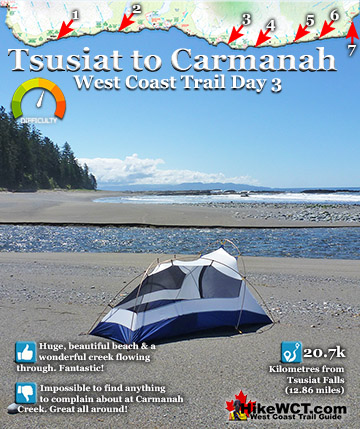
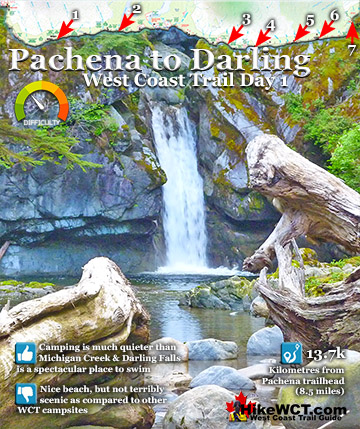
Explore BC Hiking Destinations!

The West Coast Trail

Victoria Hiking Trails

Clayoquot Hiking Trails

Whistler Hiking Trails
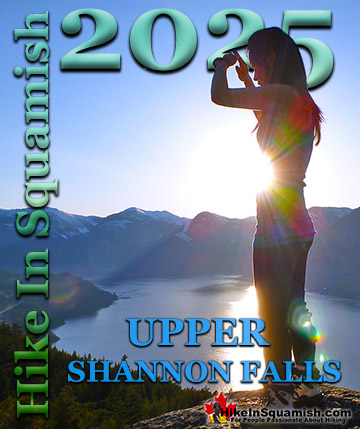
Squamish Hiking Trails

Vancouver Hiking Trails

